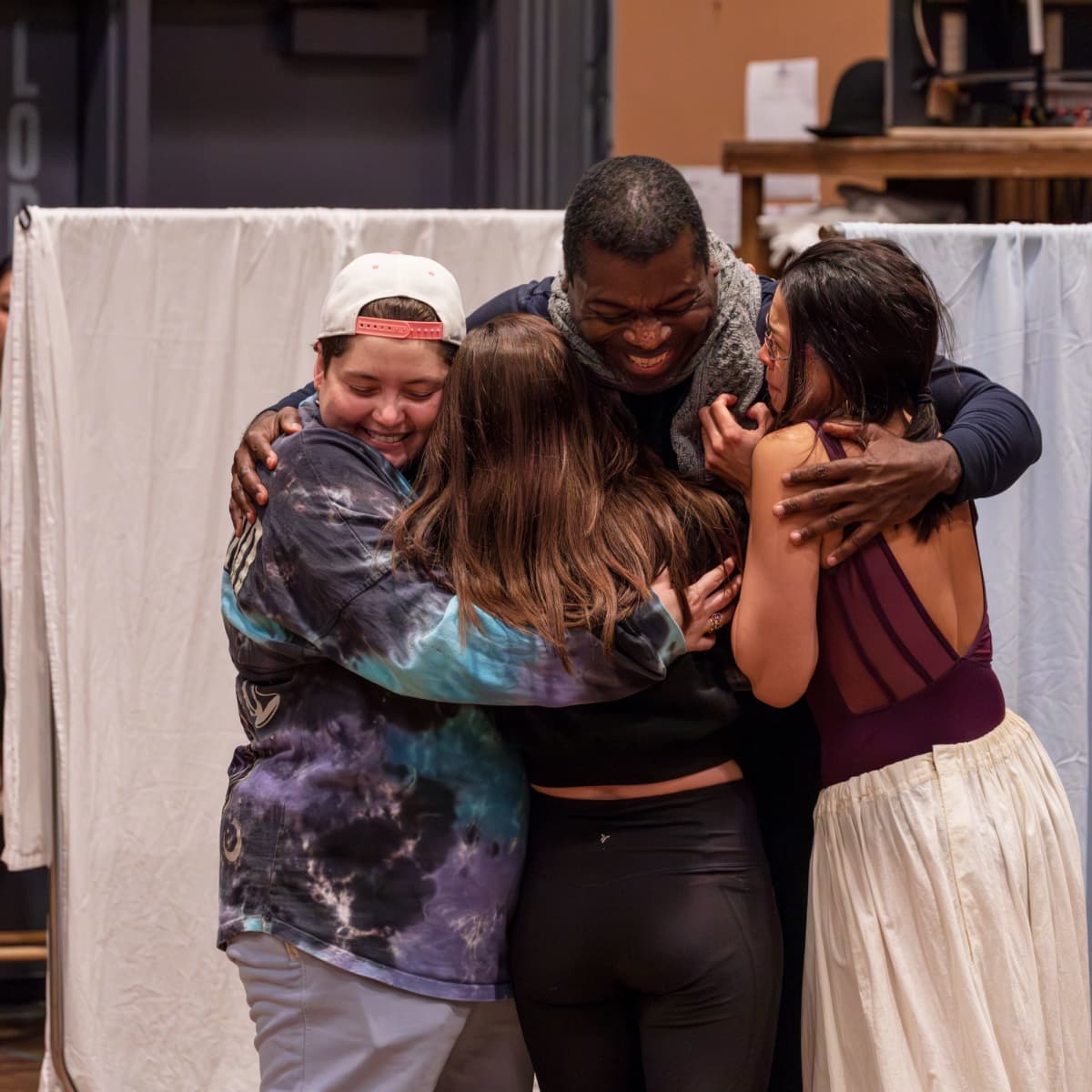What Your 1970 Textbook Didn’t Teach You
17,000 B.C.E.
Oldest settlements in North America: Meadowcroft Rockshelter, located west of what is today PA
Archaeological evidence signals this site as the first settlements in the continent, as far as we know currently. It is located 27 miles from Pittsburgh. It was constantly occupied by different communities, until it was abandoned in the 18th century, during the American Revolutionary War. The dates are in discussion, but it seems that the place was occupied for the first time between 19,000 and 16,000 years ago. The oldest town in what is now the Americas is the Oraibi settlement founded by the Hopi in Navajo country. It was established and has remained inhabited since before the 12th century.
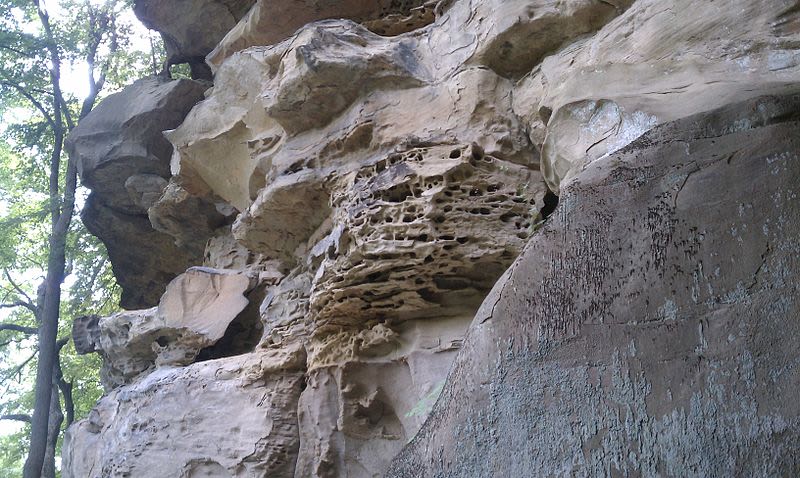
Exterior sandstone overhanding cliff at Meadowcroft Rockshelter.
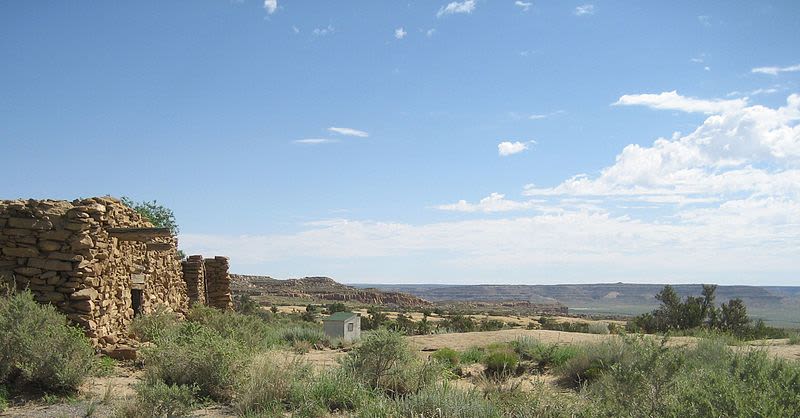
Stone house at Oraibi.
1491
Maybe the last good year
1492
Columbus arrives
With the fall of Constantinople in 1453, the traditional commercial routes between Europe and Asia (primarily India and China) were interrupted, leading to the search for new commercial routes. Portuguese explorer Vasco da Gama traveled around the continent of Africa, but Christopher Columbus was convinced that a faster way would be across the Atlantic, under the (still-not-accepted-by-some-contemporaneous-or-contemporary-Europeans) hypothesis that the world was round. He looked for funding from court to court until the Spanish monarchs agreed to give him money. His arrival in what is now called the Caribbean started the process of European colonization and the kidnapping, murder, and displacement of Indigenous folks. His infamous writings speak about sirens and mythic creatures, apparently inventing a lot of shit to make the Americas feel more exotic.
1565
First European settlements in Turtle Island
Turtle Island is the name many Algonquian- and Iroquoian-speaking peoples, including The Lenape, use to refer to the continent of North America.
The colonization of North America had many phases. The first Europeans in these lands were Norse explorers who settled in what is now Greenland in the 10th century, and afterwards in what today is Canada. Then, the Spanish messed everything up. Not happy with the conquest of the Aztec Empire by Hernán Cortés (1519) and of the Inca Empire by Francisco Pizarro (1532), these dumbasses invaded what is now Florida in 1565. The first permanent English settlement was in 1607, in what is now Virginia. The French were not as immediately good at messing things up as the Spanish and failed at settling for a while. They finally succeeded in 1634, in today’s Wisconsin.
1776
American Revolution
The first English settlements were politically dependent on Queen Elizabeth who was dead by the Revolution even though she may also be immortal. But by the 1770s, the colonizers no longer wanted to colonize under the British flag, they wanted to be free to colonize on their own and decided to throw a lot of tea to the sea, and then shoot at the British Army. You can learn about this by listening to Hamilton. Also, if you haven’t read the whole thing, now is a good time to learn or remember that the Declaration of Independence was grounded in Indigenous genocide and stolen land and in the enslavement of African peoples. So, you know: Unalienable rights like life, liberty, and the pursuit of happiness for some.
1876
Battle of Little Bighorn
In 1874, gold was found in Sioux territory (in modern-day South Dakota). Ulysses S. Grant’s administration made an offer to buy the land, but it was rejected by the Sioux. The U.S. federal government responded with military aggression. In 1876, the Lakota, Northern Cheyenne, and Arapaho tribes allied against U.S. forces, with an overwhelming Indian victory. The leadership of Crazy Horse (Oglala Lakota) and Chief Gall (Hunkpapa Lakota) ensured victory.
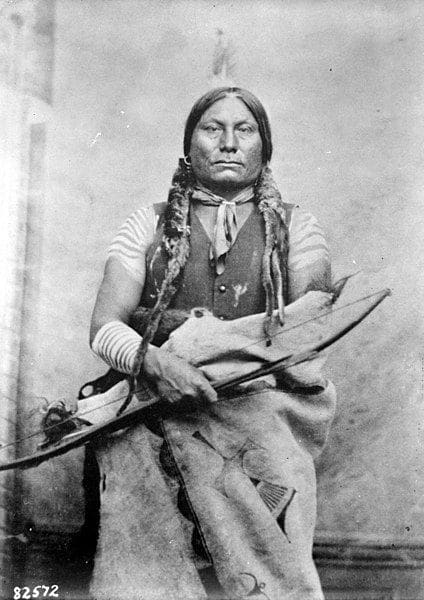
Chief Gall, great war chief of the Hunkpapa Lakota (1881).
1890
Massacre at Wounded Knee
The U.S. government continued to seize or attempt to seize Native lands through negotiations, or should we say, “negotiations.” When these “negotiations” failed, the colonizers responded in ways like starving Indigenous communities, forced assimilation and kidnapping children to Christian boarding schools, or open war. Messed up, right? During this period, the U.S. government broke a zillion treaties and divided the Great Sioux Reservation into five smaller zones. Along with forced assimilation came the U.S. government’s clampdown on Native cultural and religious practices, like the Ghost Dance. And they also had government-hired Indian police.
Early in the morning of December 19, 1890, these capos came to arrest leader Sitting Bull (Hunkpapa Lakota) for being too strong and influential and generally being a threat to the land grab and genocide, but they said it was for not stopping his people from participating in Ghost Dances. A crowd gathered, altercations ensued, and Sitting Bull was shot to death.
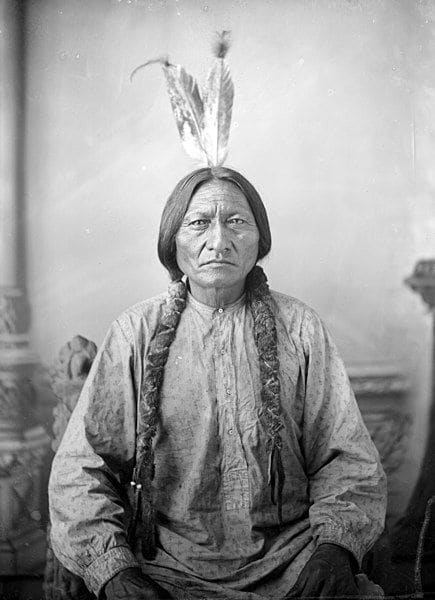
Sitting Bull, Hunkpapa Lakota chief and holy man (c. 1883).
As a result, known Indian troublemaker (he was actually listed that way in U.S. Army documents) Spotted Elk (Miniconjou Lakota) took his followers to Pine Ridge, looking to meet with Chief Red Cloud (Oglala Lakota) and the other Lakota leaders. They set up camp at the Wounded Knee Creek, where they were found by the U.S. Seventh Cavalry on December 29, 1890. In the massacre that followed, U.S. soldiers murdered approximately 300 people, the vast majority of whom were women and children.
- Our play Between Two Knees starts with this massacre, from which Isaiah is kind of rescued.
 Spotted Elk, chief of the Miniconjou Lakota, known for his political skills and diplomacy (1888). |
 Chief Red Cloud, chief of the Oglala Lakota, considered one of the most influential Native American leaders in the Great Plains region during the nineteenth century (c. 1880). |
1879-1968
Boarding Schools
In 1879, Richard Henry Pratt founded the Carlisle Indian Industrial School in Pennsylvania, attempting to “civilize” Native Americans by stripping away their culture. By removing young children from their communities, these institutions attempted to erase their heritage and identity, in order to assimilate them into white mainstream society. His idea was: “Kill the Indian to save the man”? Anyway, many more boarding schools sprung up all around the country ripping children away from their families and communities. It was common that school authorities abused, raped, or molested the students, and it is unknown how many children died at these schools. In 1968, president Lyndon B. Johnson ended this practice, and the Indigenous nations were able to manage the schools on their own terms. It was only just recently that Pope Francis acknowledged and apologized for the Catholic Church’s role in these criminal institutions.
- In Between Two Knees, Irma and Isaiah meet in a boarding school.
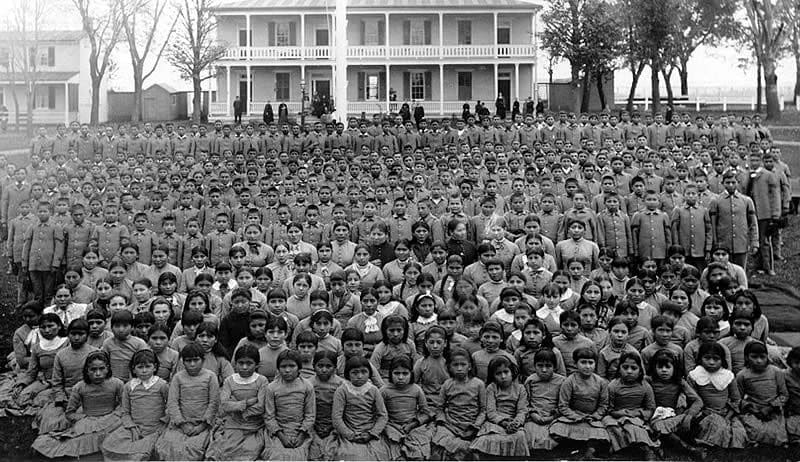
Students at the Carlisle Indian Industrial School in Carlisle, PA. Between 1879 and 1918, more than 10,000 Native American children from 140 tribes were sent to Carlisle (c.1900).
1914-1918
WWI
After centuries of colonialism and invasion of other nations, World War I was a conflict sparked by European countries seeking to achieve supremacy by invading nations on their own continent again and spreading out into Africa and the Middle East and blowing up ships in the Atlantic. And there was something about an Archduke who has a band named after him now. After four years of brutal conflict, peace was negotiated to stop the destruction. This war is not mentioned in the play, but we wanted you to know that 12,000 Native Americans fought for the U.S. during WWI.
1939-1945
WWII
World War II was a conflict fundamentally between the Axis powers (Germany, Japan, and Italy) and the Allies (UK, USA, USSR, and China) that affected most countries in the world. The U.S. had stayed kind of neutral until 1941, when Japan attacked the naval base of Pearl Harbor in Hawaii. This war was one of the most brutal in human history, destroying many cities in Europe, killing perhaps 80 million people including an estimated 6 million Jews. Victory in Europe came in May, 1945, but the war didn’t fully end until about 100,000 more civilians died in August, 1945 with the dropping of two Atomic Bombs on Japan, leading to their final surrender. 25,000 Native Americans fought for the U.S. in WWII, including the famed Navajo Code Talkers.
- In the play, Isaiah and Irma’s son William proudly enlists to fight in WWII.
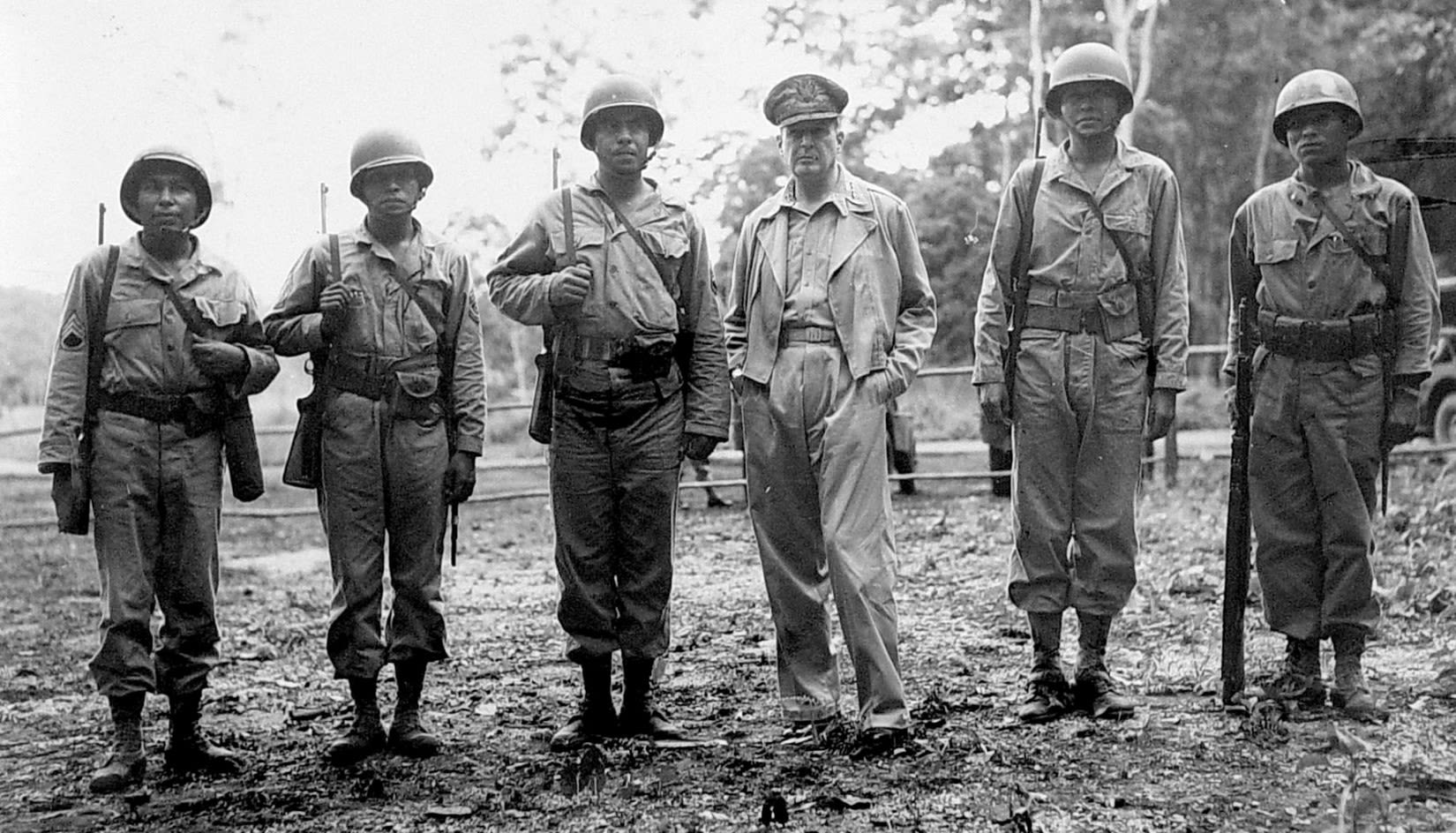
S/Sgt. Virgil Brown (Pima), First Sgt. Virgil F. Howell (Pawnee), S/Sgt. Alvin J. Vilcan (Chitimacha), Gen. Douglas MacArthur, S/Sgt. Byron L. Tsignine (Navajo), Sgt. Larry L. Dokin (Navajo). This US Army Signal Corps “Official Photo 17641” was published nationwide in newspapers in February 1944, noting MacArthur meeting five Native American troops serving in one unit. At least two of those pictured, S/Sgt. Tsignine and S/Sgt. Vilcan, were members of the top-secret reconnaissance and radar unit The Alamo Scouts, a forerunner of Special Forces.
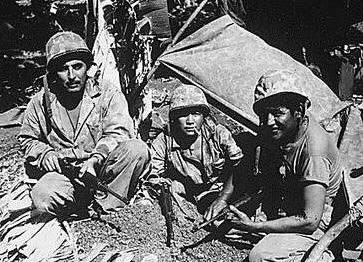
Navajo Code Talkers, Saipan (June 1944). The Marine Corps’ Navajo Code Talker Program was established in September 1942, when the US Military instituted a specific policy of recruitment and training of speakers of Native American language speaker. Code Talker was the name given to Native Americans who used their tribal languages to send secret communications on the battlefield. At least fourteen other Native nations, including the Choctaw, Cherokee and Comanche served in the Pacific and Europe.
1945-1989
Cold War
The end of these World Wars left two superpowers: the U.S. and the Union of Soviet Socialist Republics (USSR). Both struggled for global power and influence of their economic doctrines (capitalism and socialism, respectively and supposedly), while avoiding direct armed confrontation between these two nations. This Cold War unfolded in two main ways: the threat of mutually assured annihilation through the development of weapons of mass destruction, and proxy wars, where the superpowers used other countries to fight in armed confrontation. Two of the major armed conflicts in this period were the Korean War and the Vietnam War.
1950–1953
Korean War
At the end of World War II, the USSR occupied the northern region of Korea, while the U.S. occupied the southern region. This created two new sovereign states, and in 1950 a war between North and South Korea started. Both superpowers became involved, leading to 3 million deaths, thousands of massacres, and destruction of all Korean major cities, until an armistice was signed in 1953.
- 10,000 Native Americans fought for the U.S. in Korea, including a damaged and violent guy we meet in a scene of our play.
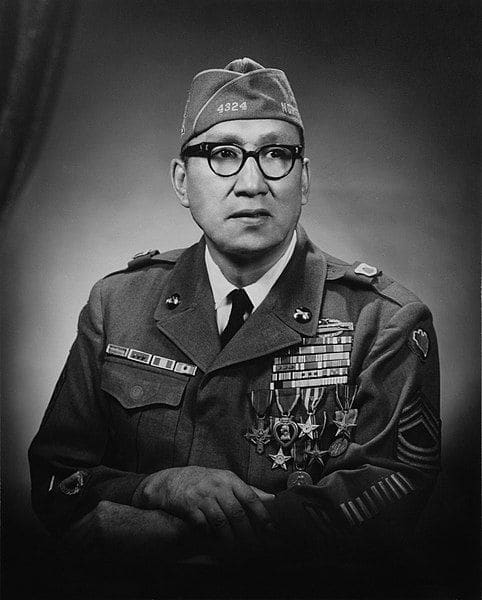
MSgt. Woodrow W. Keeble (Sisseton Wahpeton Oyate) served in World War II and reenlisted for duty in Korea where he risked his life in one of the last major U.S. offensives of the war. For his actions, he was posthumously awarded the Medal of Honor in 2008.
1955ish-1975
Vietnam War
The Vietnam War was an armed conflict between North Vietnam, supported by the USSR, and South Vietnam, supported by the U.S. Negative public opinion, pressure from U.S. citizens, and depleted funds for war expenses, led the U.S. to recall troops from Vietnam in 1975. The calculation of casualties ranges from 1.4 to 3.6 million, including so many civilians. More than 42,000 Native Americans fought for the U.S. in Vietnam.
Many popular movies were made about this war (like Apocalypse Now, directed by Francis Ford Coppola; Full Metal Jacket, directed by Stanley Kubrick; and Forrest Gump, directed by Robert Zemeckis).
- In Between Two Knees, Eddie fights in the Vietnam War, and this sequence is just like those films.
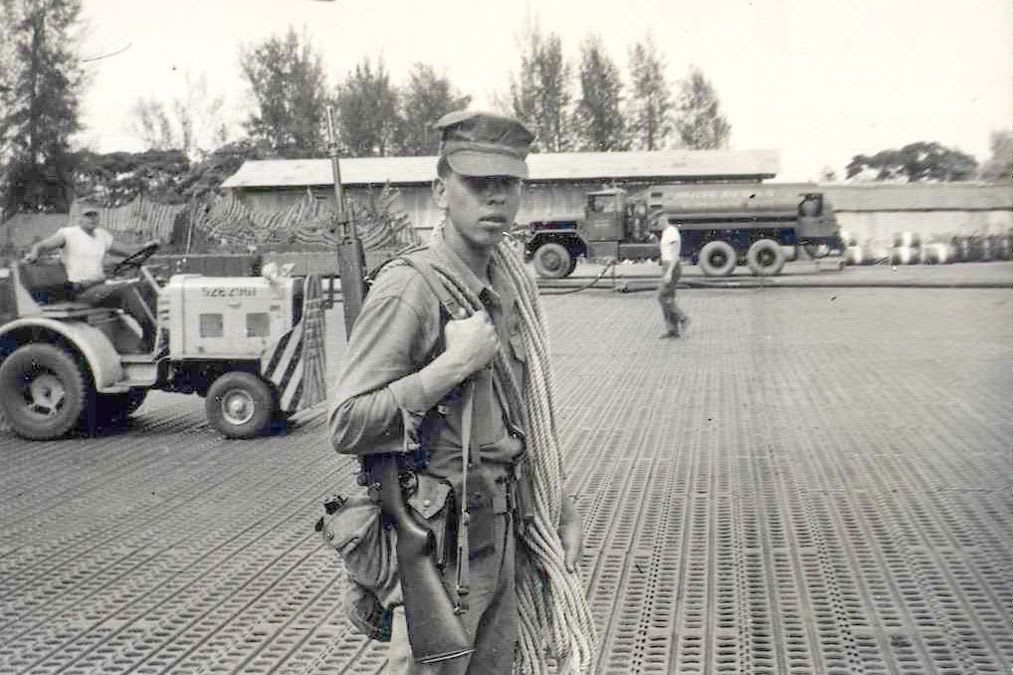
LCpl. Harvey Pratt (Cheyenne and Arapaho) served in the 3rd Marine Division and was stationed in Da Nang. After the war he worked in law enforcement and became a nationally renowned forensic artist. He created the winning concept design for the National Native American Veterans Memorial (c. 1963).
1968
The American Indian Movement
The American Indian Movement (AIM) was founded in Minneapolis by a group of formerly incarcerated Native Americans. In the wake of the Indian Relocation Act of 1956 and several other government initiatives that pushed Native Americans from their lands, away from their people, and into forced assimilation and cultural forgetting, AIM fought to reestablish Indian rights and sovereignty. Like many political and radical groups established at this time, they took action to address poverty, police brutality, and discrimination, in their case specifically against Indigenous people, framing these issues as a consequence of settler colonialism in the Americas.
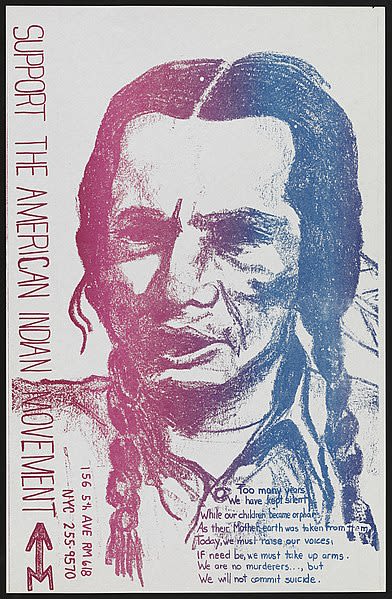
“Support the American Indian Movement” promotional poster (c. 1968-1980).
1970
Keep America Beautiful
Chief Iron Eyes Cody cries on a commercial to protest littering. It has a tremendous effect. Truth is that Iron Eyes was actually Italian and named Espera Oscar de Corti. He denied being merely Italian. No one cared much that he wasn’t a real Indian, but everyone remembers the commercial and feels bad if they litter.
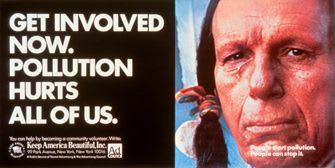
The “Crying Indian” of the now infamous “Keep America Beautiful” Earth Day ad campaign (1971; The AD Council).
1973
Occupation of Wounded Knee by AIM
In just 5 years, AIM had undertaken several actions including the takeovers at Alcatraz Prison in California, the Bureau of Indian Affairs in Washington, D.C., and a replica of the Mayflower in Massachusetts. And now, we are back where our play began about an hour and a half ago.
Richard Wilson was elected president of the Oglala Lakota in the Pine Ridge Indian Reservation the year before. Longstanding tensions rose to the surface, mostly because Wilson was corrupt and abusive. Residents turned to AIM, who tried to impeach him. When this failed, they occupied the town of Wounded Knee in 1973, questioning the failure of the U.S. government to fulfill treaties with Indigenous communities and demanding negotiations. Watergate was going down at the same time, so Nixon and his administration were distracted and disinterested.
Meanwhile, to support the AIM occupation, activist Sacheen Littlefeather used the Oscar ceremony to bring attention to what was going on at Wounded Knee. She had gotten in touch with Marlon Brando and asked for his support of AIM and the protesters. So Brando boycotted the ceremony, and when his name was announced as the winner for Best Actor for The Godfather, Littlefeather delivered a speech protesting against Hollywood's representation of Indigenous people. Six guards had to restrain John Wayne, who tried to hit her. We wanted to highlight this because it’s way more interesting than what happened between Will Smith and Chris Rock, people.
The FBI confronted AIM through public defamation and siege. There were shootings, which wounded and killed several protesters, and activist Ray Robinson disappeared. The occupation lasted 71 days, after which peace was negotiated at the behest of Lakota elders. Wilson remained in power, in one of the few displays of respect for Indian Sovereignty by the U.S. Government who said they could not remove an elected leader of an Indian nation.
- Our play has an amazing climax at the Second Wounded Knee that causes time to completely collapse and reset. Really.
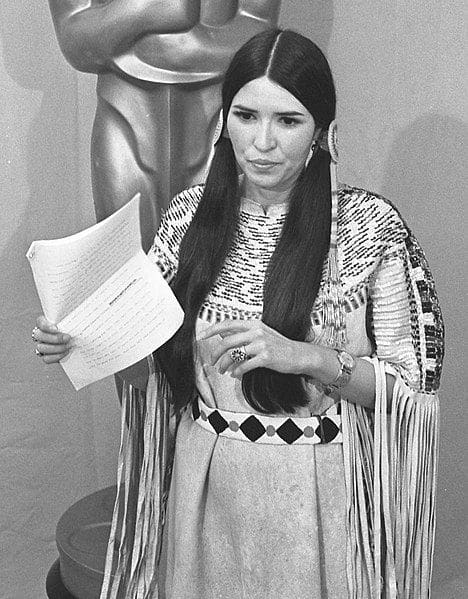
Sacheen Littlefeather at the 45th Academy Awards holding Marlon Brando’s statement (1973; UCLA Library Special Collections).

